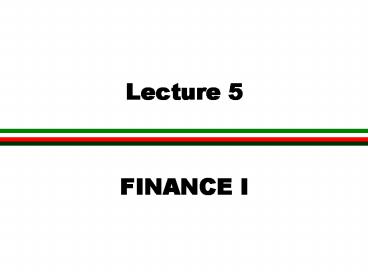FINANCE I PowerPoint PPT Presentation
1 / 22
Title: FINANCE I
1
Lecture 5
- FINANCE I
2
Lecture Objectives
- 1. Long term and short term debt
- 2. Identify cashflows in a bond
- 3. Value bond
- 4. Yield curve
3
Debt as a Sourceof Funds
- Debt - Contractual claim on the firm
- Fixed periodic interest payment
- - Usually a fixed principal repayment to
retire the loan
4
Short-Term Debt
- Bank overdraft
- Overdraw on current account
- Usually an upper limit on overdraft
- Inter-company Loans
- Direct lending between firms
- Commercial Bills
- Short-term loan than is usually endorsedby a
third party - Promissory Notes
- One-name paper that do not require thirdparty
endorsement - Trade credit
- Deferred payment for good and services
5
Long-Term Debt
- Term loans and mortgage loans
- Mortgage against property
- Fully drawn advances
- Like an overdraft facility but fora longer
period, usually five years - Leases
- Contract between lessor and lessee forperiodic
payment for use of asset - Debentures
- Entails a fixed interest payment and aprincipal
payment to discharge the debt. - Debt is secured against the issuers asset
6
How to Issue Debentures
- Public issue
- Issued to public through a prospectus
- Family issue
- Issued to equity, debenture and debtholders
- Private placement
- Issued to institutional investors
7
Bond/Debenture
- Long term loan
- Issued by government and corporation
- Cashflows provided by bonds
- Coupon fixed repayment on the loan based on a
percentage of the face value
8
Bond/Debenture
- Face value
- Also called par value or maturity value. The
principle value that is repaid when the bond is
retired. - Maturity date
- Date at which the bond expires
9
Bond/Debenture
- JANUARY 2005 - Maturity Date
- - A 5 yr Bond
- BHP - Organisation responsible for the
interest and maturity payouts - 100,000 - Amount to be received on
Maturity - FACE VALUE - Coupon _at_ 10 - Interest paid per year
- - ie 10,000
10
Bond/Debenture
- Cashflow provided by such a bond
- Bonds are discount instruments
- ie their value is the discounted value
- Value is determined by discounting all expected
coupons and maturity payouts by an appropriate
discount rate Rb(or i)
11
Bond/Debenture
12
Bond/Debenture
- The discount rate that we use is the market rate
or yield. If the yield on the bond is 8 what is
the price of the bond? - Can you think of another wayof working out the
answer?
13
Example 1
- A 10-year government bond offers a coupon rate of
10 per annum. What is the price of the bond if
the yield on the bond is 12 per annum and the
face value is 1000. - What happens as if the yield falls to 8?
- What happens if the yield rises to 14?
14
Bond/Debenture
- As observed from the above example
- There is an inverse relationship between the
discount rate and the price. - The discount rate is market driven
- it varies according to the supply and demand for
bonds
15
Bond/Debenture
- Note - If the Coupon Rate and Kb are the same -
ie 10 - Price of the Bond its Face Value 1000
- If C.R Kd If C.R gt Kd
- 10 10 10 gt 8
- Then PV FV Then PV gt FV
- 1134.2 gt 1000
- If C.R lt Kd
- 10 lt 14
- Then PV lt FV
- 791.4 lt 1000
16
Example 2
- What if the bond above is paying semi-annual
coupons. What is the price if the yield is 12
p.a.?
17
Bond/Debenture
- Yield to maturity Discount rate that equates
the present value of the cashflows to its price. - - the return one gets if holds the bond
until the day it matures. - - it is equivalent to IRR
18
Example 3
- A 100, 3-year bond is currently trading at
108.5. If the coupon rate is 12 paid annually,
what is the current yield, and what is the yield
to maturity?
19
Example 4
- (Effective Nominal YTM)
- A 13, 100 bond that pays interest semi-annually
is currently selling for 94. If the bond has 5
years to mature, what is the nominal and
effective yield to maturity? - r 7.37 per half annum
- Nominalper year 7.37 x 2 14.78
- EffectivePer year (1.0737)2 - 1 15.32
20
Bond/Debenture
- The required return on bonds (Rb) depends on Risk
/ Inconvenience / Inflation - Risk - is a function of time and who owes
you the money. - Government - Federal
- - State
- - Local
- - Private Cos - Blue Chip
- - Green Chip
21
Bond/Debenture
- Time - More time to default
- - Greater impact of inflation
- - Greater inconvenience
- When choosing a Kb to value a bond, take care to
choose one indicative of the same MATURITY AND
CLASS as the bond examined. - "Get from The West Australian Australian
Financial Review"
22
Inflation and the Time Value of Money
- If you determined your nominal YTM on a bond to
be 14 p.a and inflation is currently running at
7, what is your real return. - R ( 1.14/1.07 ) - 1 6.54

